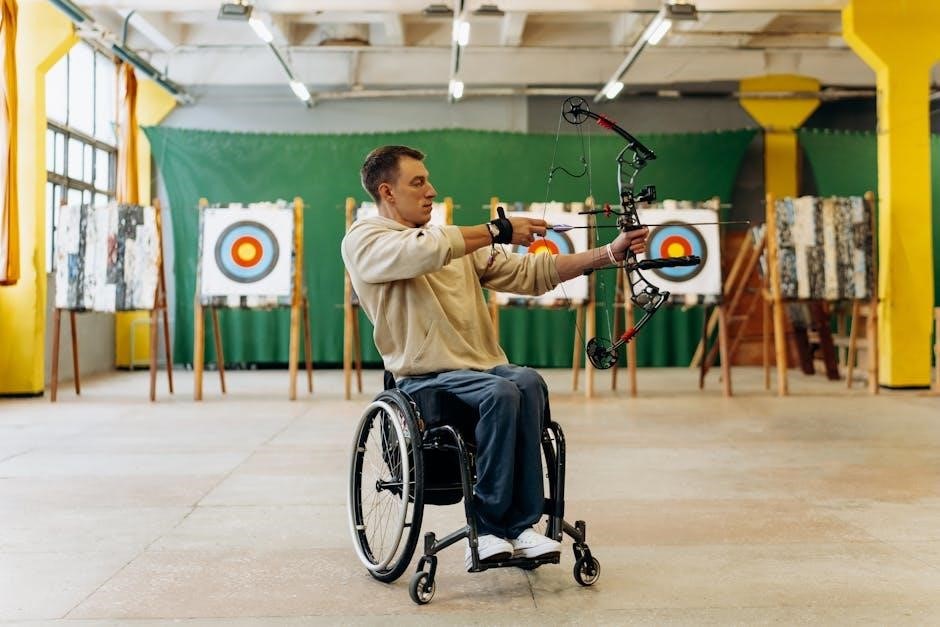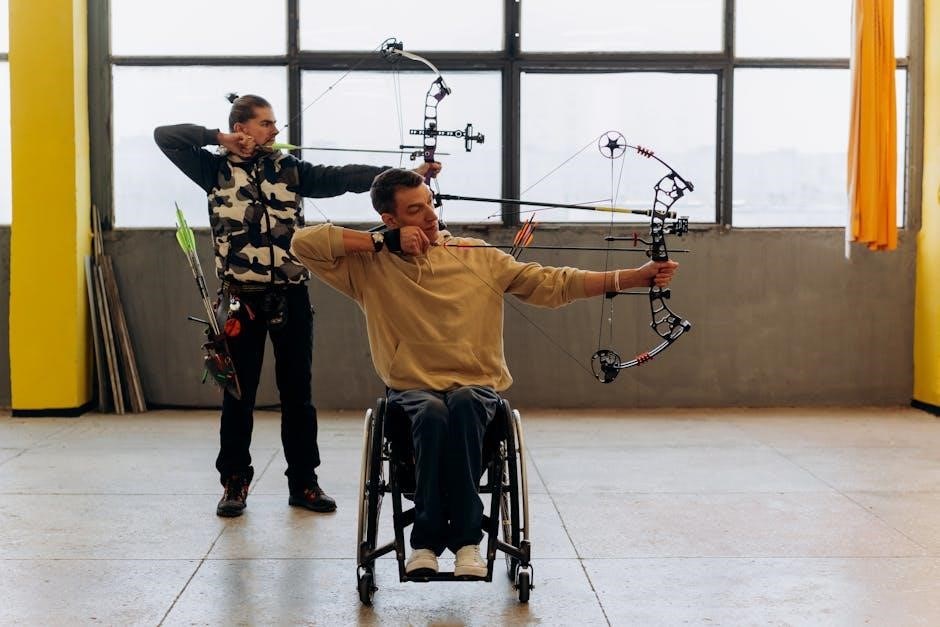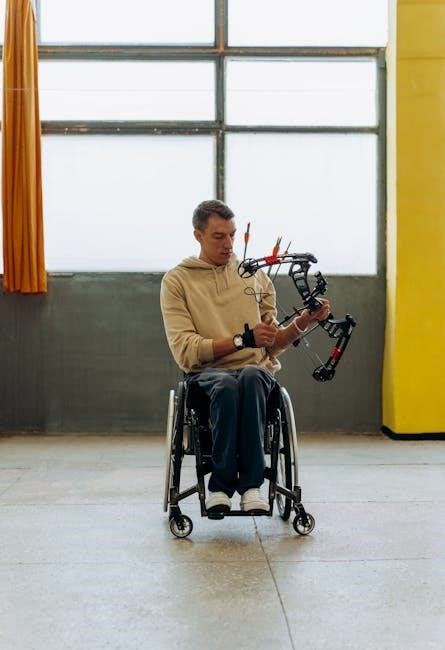
Embark on your Olympic triathlon journey with a structured 16-week training plan‚ designed to build endurance and peak performance through swim‚ bike‚ and run workouts.
Understanding the Olympic Triathlon Distance
The Olympic triathlon distance consists of a 1.5km swim‚ 40km bike ride‚ and 10km run‚ totaling 51.5km. Each segment demands specific skills and endurance. The swim requires open-water proficiency‚ the bike focuses on cadence and gear management‚ and the run tests stamina. Athletes must master transitions between disciplines and maintain consistent pacing. This distance is a significant test of endurance‚ requiring a structured training plan to build strength and efficiency across all three sports. Understanding the demands of each phase is crucial for effective preparation and achieving peak performance on race day. Proper training ensures athletes are ready for the challenge.
Importance of a Structured Training Plan
Importance of a Structured Training Plan
A structured training plan is essential for Olympic triathlon preparation‚ ensuring balanced progress across swimming‚ cycling‚ and running. It prevents overtraining and injury while building endurance and skill. A well-designed plan includes phases like base‚ build‚ and peak‚ each focusing on specific goals. Recovery weeks are crucial to avoid burnout and allow the body to adapt. By following a structured schedule‚ athletes can systematically improve their swim efficiency‚ cycling cadence‚ and running stamina. This approach ensures consistency‚ reduces the risk of overtraining‚ and maximizes performance on race day. A structured plan is vital for achieving peak fitness and confidence in the Olympic triathlon distance.
Phases of an Olympic Triathlon Training Plan
An Olympic triathlon training plan typically includes four phases: Base (weeks 1-6)‚ Build (weeks 7-11)‚ Peak (weeks 12-14)‚ and Recovery/Taper (weeks 15-16). This structured approach ensures progressive fitness development leading up to race day.
Base Phase (Weeks 1-6)
The Base Phase (Weeks 1-6) focuses on building foundational fitness and endurance across all three disciplines. This phase emphasizes consistency and gradual progression. Swim workouts include technique drills and endurance sessions‚ while bike sessions focus on zone-based training to improve cardiovascular fitness. Running involves building a steady aerobic base with interval workouts. Strength training is also incorporated to enhance overall athleticism and prevent injuries. The goal is to establish a solid aerobic foundation‚ ensuring athletes can handle the intensity of later phases. This period is crucial for developing muscle memory and endurance‚ setting the stage for more intense training in the Build Phase.
Build Phase (Weeks 7-11)
The Build Phase (Weeks 7-11) focuses on increasing intensity and building speed while maintaining endurance. Workouts become more sport-specific‚ with swim sessions incorporating interval training and threshold pace work. Bike rides emphasize zone 3-4 efforts and longer endurance rides to simulate race conditions. Running includes tempo runs and interval sessions to improve speed and lactate threshold. Brick workouts (bike-to-run transitions) are introduced to enhance race-specific fitness. Strength training continues to support overall performance and injury prevention. This phase is critical for developing race pace and mental resilience. Consistency and progressive overload are key to preparing for the peak phase ahead.

Peak Phase (Weeks 12-14)
The Peak Phase (Weeks 12-14) is designed to maximize fitness and race-specific skills. Workouts focus on high-intensity interval training (HIIT)‚ race-pace simulations‚ and sport-specific drills. Swim sessions emphasize speed and endurance‚ while bike workouts include threshold rides and cadence drills. Running incorporates tempo runs and hill repeats to build explosive power. Brick workouts (bike-to-run transitions) are intensified to mimic race-day conditions. Strength training is reduced to prioritize sport-specific efforts. This phase is crucial for building speed‚ endurance‚ and mental stamina. Athletes should taper slightly in volume while maintaining intensity to ensure peak performance for race day. Rest and recovery are prioritized to avoid burnout.

Recovery and Taper Weeks (Weeks 15-16)
Recovery and Taper Weeks (Weeks 15-16) are crucial for allowing your body to heal and prepare for race day. Training volume is significantly reduced while maintaining some intensity to keep fitness levels sharp. Swim‚ bike‚ and run sessions focus on technique and active recovery‚ with low-intensity workouts replacing high-mileage efforts. Strength training is minimized‚ and rest days are emphasized to promote recovery. Proper nutrition and hydration are highlighted to ensure optimal energy levels. These weeks are designed to prevent injury and mental burnout‚ ensuring you arrive at the start line fresh and ready to perform at your best.

Weekly Training Structure
A balanced mix of swim‚ bike‚ and run sessions‚ with drills‚ intervals‚ and zone training. Each week includes rest days and active recovery to optimize performance and health.
Sample Weekly Breakdown
A typical week includes 7 days of structured training‚ with a focus on swim‚ bike‚ and run sessions. Monday is often a rest or active recovery day. Tuesday might feature a bike workout‚ such as zone 2 endurance riding‚ while Wednesday includes a swim session with drills and intervals. Thursday is dedicated to a run‚ incorporating speed and endurance exercises. Friday includes another swim session‚ focusing on technique and strength. Saturday involves a longer bike ride or brick workout‚ combining bike and run segments. Sunday is reserved for active recovery‚ such as a light run or yoga. This structure ensures balanced progress across all disciplines while allowing for recovery.
Swim‚ Bike‚ and Run Workouts
Swim workouts focus on drills‚ intervals‚ and endurance sessions‚ such as 4x50m drills and 800m main sets in zones 2-3. Bike sessions include zone 2 endurance rides and brick workouts combining bike and run. Run training involves speed intervals‚ like 3x1200m at threshold pace‚ and longer endurance runs. Each discipline is tailored to build specific skills and endurance‚ ensuring a balanced approach to triathlon preparation. Workouts are structured to progressively increase intensity and duration‚ with rest days and recovery weeks integrated to prevent overtraining. This comprehensive approach ensures athletes develop the stamina and technique needed for the Olympic triathlon distance.

Sport-Specific Workouts

Sport-Specific Workouts
Structured swim‚ bike‚ and run workouts are tailored to enhance endurance‚ speed‚ and technique. Each session is designed to target specific skills and build overall triathlon performance effectively.
Swim Workouts: Drills and Intervals
Swim workouts focus on building endurance‚ speed‚ and technique through structured drills and intervals. A typical session begins with a 200m warm-up‚ followed by drills like catch-up and high-elbow exercises to improve stroke efficiency. The main set includes 800m intervals in zones 2-3‚ targeting aerobic endurance‚ and 4x100m sprints for speed. Cool-down stretches and breathing exercises complete the session. These workouts are designed to enhance swim performance‚ ensuring athletes are race-ready for the 1.5km Olympic distance. Consistency and progression are key to mastering the swim leg of the triathlon.

Bike Workouts: Zone Training and Long Rides
Bike workouts are crucial for building endurance and speed. Start with a 10-15 minute warm-up‚ then transition into zone 2 for steady endurance rides. Incorporate high-intensity intervals in zone 3-4 for threshold improvement. Long rides‚ such as 60-90 minutes‚ simulate race conditions and enhance mental toughness. Brick workouts‚ combining bike and run sessions‚ are introduced to mimic race-day transitions. These structured sessions ensure progressive overload‚ helping athletes adapt to the demands of the 40km bike leg. Consistency in zone training and long rides is essential for peak performance in the Olympic triathlon.
Run Workouts: Speed and Endurance Sessions
Run workouts are tailored to enhance both speed and endurance. Begin with a 10-15 minute warm-up‚ including dynamic stretches and light jogging. Incorporate interval training‚ such as 4-6 x 800m at threshold pace‚ to improve lactate threshold and speed. Tempo runs‚ like 20-30 minutes at a moderate pace‚ build aerobic endurance. Long slow distance (LSD) runs‚ lasting 60-75 minutes‚ simulate race conditions and boost mental resilience. Brick workouts‚ combining bike and run sessions‚ mimic race transitions. Progression is key‚ with gradual increases in intensity and volume. Consistency in these workouts ensures athletes are race-ready for the 10km run leg of the Olympic triathlon.

Nutrition and Recovery Strategies
A balanced diet‚ hydration‚ and recovery techniques like stretching and foam rolling are essential for optimal performance and injury prevention in triathlon training.
Fueling for Performance
A well-balanced diet is crucial for triathlon success. Focus on complex carbs for sustained energy‚ lean proteins for muscle repair‚ and healthy fats for optimal function. Hydration is key‚ especially during intense workouts. Practice race-day nutrition by timing meals and snacks to avoid digestive discomfort. Incorporate electrolytes and energy gels during long rides and runs to maintain performance; Avoid experimenting with new foods on race day to prevent stomach issues. Tailor your nutrition plan to your training phases‚ increasing calorie intake during high-volume weeks and adjusting macronutrient ratios based on activity levels. A personalized approach ensures peak performance and supports recovery.
Recovery Techniques for Optimal Progress
Recovery is a cornerstone of any effective Olympic triathlon training plan. Incorporate rest days to allow your body to heal and adapt. Prioritize hydration and nutrition to replenish energy stores and support muscle repair. Aim for 7-9 hours of quality sleep nightly to aid physical and mental rejuvenation. Engage in active recovery techniques like stretching‚ yoga‚ or light swimming to promote blood flow without overexertion. Use tools like foam rollers or compression gear to reduce muscle soreness. Schedule regular massages or ice baths to enhance recovery. By balancing training with proper rest and recovery‚ you ensure consistent progress and peak performance on race day.

Selecting the Right Training Plan
Choose a plan based on your experience‚ goals‚ and availability. Options include 12- or 16-week plans‚ designed for beginners‚ intermediate‚ or advanced athletes.
Choosing Based on Experience and Goals
When selecting a training plan‚ consider your experience level and specific goals. Beginners should start with a 12-week plan‚ focusing on building a solid aerobic base. Intermediate athletes can opt for a 16-week plan‚ incorporating intensity and endurance. Advanced triathletes may benefit from high-volume plans or specialized coaching. Assess your current fitness level and race goals to align with the plan’s structure. If you’re stepping up from shorter distances‚ ensure the plan addresses your weaknesses‚ such as swim efficiency or bike endurance. Choose plans designed by experienced coaches‚ like Dermott Hayes‚ for tailored workouts. Adjust the plan to fit your lifestyle and schedule for optimal results;
Customizing the Plan for Individual Needs
A one-size-fits-all approach rarely works‚ so tailor your Olympic triathlon training plan to suit your lifestyle‚ fitness level‚ and goals. Adjust workout schedules to fit your availability‚ ensuring consistency without overtraining. Incorporate strength and mobility sessions to address personal weaknesses‚ such as swim efficiency or bike power. Balance high-intensity days with recovery to prevent burnout. If you struggle with endurance‚ prioritize longer bike and run sessions. For those with busy schedules‚ focus on quality over quantity‚ optimizing each workout. Seek professional coaching or use digital tools to refine the plan further. Regularly assess progress and tweak the plan to stay on track and achieve peak performance.
Downloading and Implementing the Plan
Download the Olympic Triathlon Training Plan in PDF or Google Sheets to access structured workouts‚ swim drills‚ bike intervals‚ and run sessions. Use digital tools to track progress effectively.
Free PDF Resources and Guides
Access free Olympic triathlon training plans in PDF format‚ offering structured workouts for swim‚ bike‚ and run sessions. Choose from 12-week‚ 16-week‚ or 24-week plans designed for all fitness levels. These guides include detailed swim drills‚ bike interval training‚ and run endurance sessions. Download expert-designed plans with intensity zones‚ strength training‚ and nutrition tips. Ideal for beginners or experienced athletes‚ these resources provide a flexible framework to tailor your training. Find plans tailored to your goals‚ from improving performance to completing your first Olympic triathlon. Download directly from trusted websites and start your journey to peak fitness with comprehensive‚ easy-to-follow guides.
Using Digital Tools for Tracking Progress
Enhance your Olympic triathlon training with digital tools designed to monitor progress and optimize performance. Use apps like TrainingPeaks or Strava to log workouts‚ track metrics‚ and analyze data. Set goals‚ monitor consistency‚ and adjust training intensity with real-time feedback. GPS-enabled devices like Garmin watches provide precise metrics for swim‚ bike‚ and run sessions. Additionally‚ platforms like Zwift offer virtual training environments for structured bike workouts. Digital calendars help organize training schedules and ensure adherence to the 16-week plan. Use these tools to stay motivated‚ identify improvements‚ and fine-tune your strategy for peak performance on race day. Consistent tracking ensures accountability and helps achieve your Olympic triathlon goals.